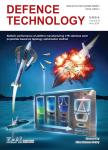Research on the intermediate phase of 40CrMnSiB steel shell under different heat treatments
Research on the intermediate phase of 40CrMnSiB steel shell under different heat treatments作者机构:ZNDY of Ministerial Key LaboratoryNanjing University of Science and TechnologyNanjing210094China
出 版 物:《Defence Technology(防务技术)》 (Defence Technology)
年 卷 期:2021年第17卷第3期
页 面:1032-1041页
核心收录:
学科分类:080503[工学-材料加工工程] 08[工学] 0805[工学-材料科学与工程(可授工学、理学学位)] 0802[工学-机械工程] 080201[工学-机械制造及其自动化]
基 金:funded by the National Natural Science Foundation of China (Grant No.11972018) sponsored by the Defense Pre-Research Joint Foundation of Chinese Ordnance Industry (Grant No. 6141B012858)
主 题:Explosive mechanics Mid-explosion recovery experiment Explosion and fracture Heat treatment SEM(Scanning electron microscope)fracture analysis
摘 要:In this study, 40 Cr Mn Si B steel cylindrical shells were tempered at 350, 500 and 600 ℃ to study the effect of tempering temperature on the dynamic process of expansion and fracture of the metal shell. A midexplosion recovery experiment for the metal cylinder under internal explosive loading was designed, and the wreckage of the casings at the intermediate phase was obtained. The effects of different tempering temperatures on the macroscopic and microscopic fracture characteristics of 40 Cr Mn Si B steel were studied. The influence of tempering temperatures on the fracture characteristic parameters of the recovered wreckage were measured and analyzed, including the circumferential divide size, the thickness and the number of the circumferential divisions. The results show that as the tempering temperature was increased from 350 to 600 ℃, at first, the degree of fragmentation and the fracture characteristic parameters of the recovered wreckage changed significantly and then became essentially consistent. Scanning electron microscopy analysis revealed flow-like structure characteristics caused by adiabatic shear on different fracture surfaces. At the detonation initiation end of the casing, fracturing was formed by tearing along the crack, which existed a distance from the initiation end and propagated along the axis direction. In contrast, the fracturing near the middle position consists of a plurality of radial shear fracture units. The amount of alloy carbide that was precipitated during the tempering process increased continuously with tempering temperature, leading to an increasing number of spherical carbide particles scattered around the fracture surface.



